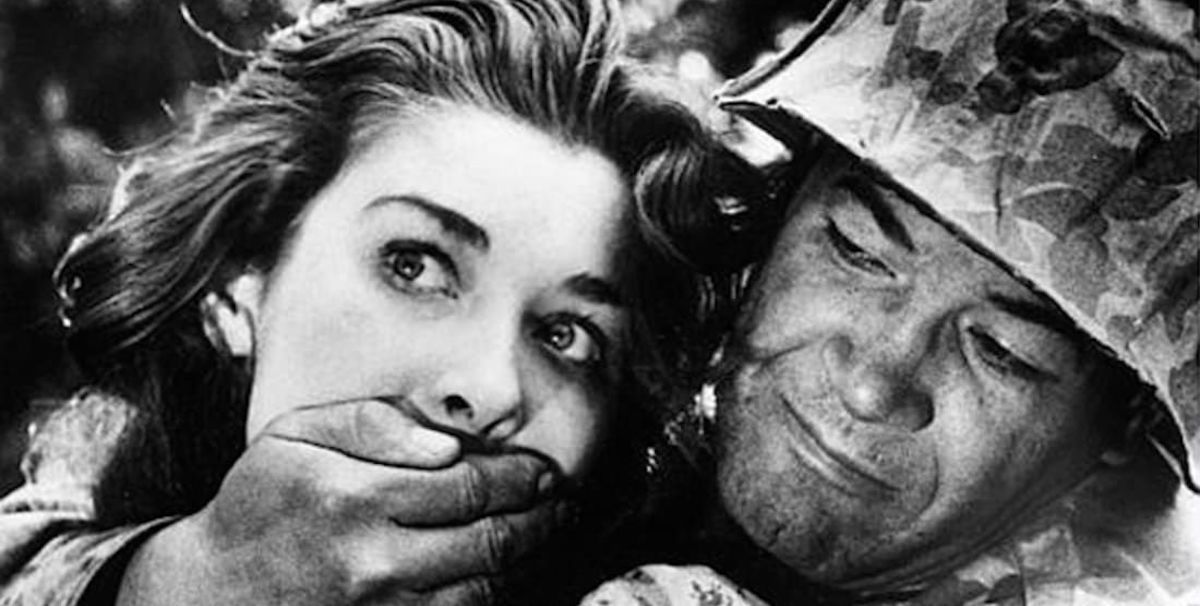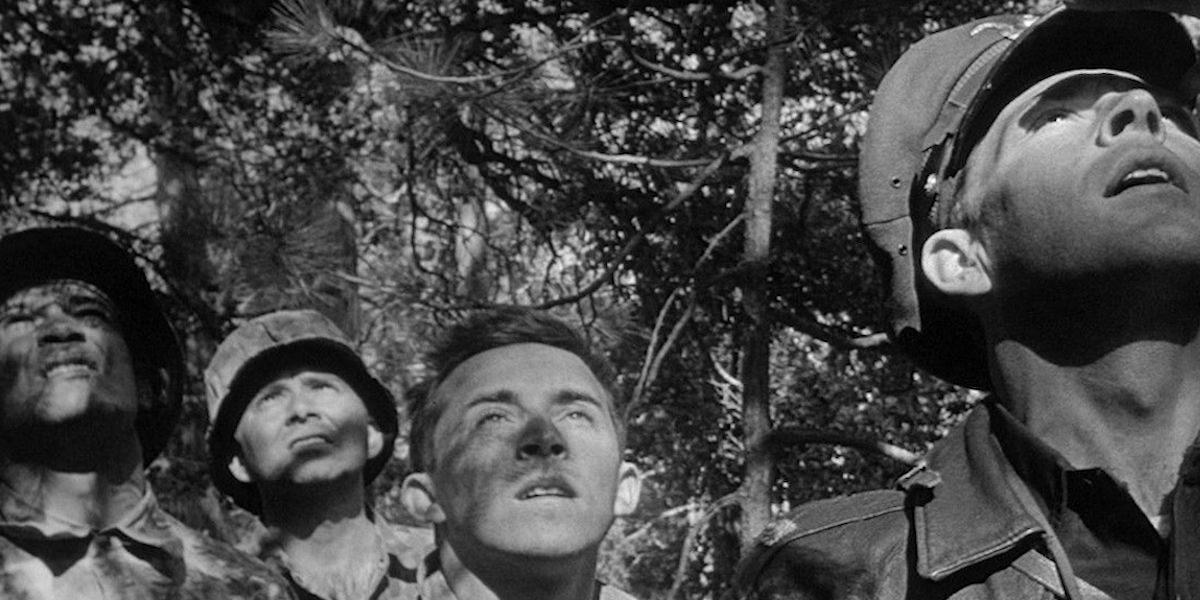[ad_1]
Having directed 13 feature films over nearly half a century, Stanley Kubrick has left an indelible mark on cinematic history. Innovative, influential, and meticulous to a tee, the trailblazer from the Bronx first picked up a camera as a teenager and made a name for himself shooting still photos for Look magazine. After transitioning to short documentary filmmaking with Day of the Fight and Flying Padre, it seemed only a matter of time before he’d try his hand at a feature-length film. With a generous financial contribution from his uncle, and using money he made hustling chess in New York City’s Washington Square Park, Kubrick went to work on what would become Fear and Desire.
After shooting in California’s San Gabriel Mountains with a minimal cast and crew, the hour-long feature debuted at the Venice Film Festival and received a short-lived theatrical distribution in 1953. But shortly after release, Fear and Desire disappeared from public view for forty years. What happened to Kubrick’s film, and how did it resurface decades later?
What Is ‘Fear and Desire’ About?
Written by Howard Sackler, a friend of Stanley Kubrick’s who would win a Pulitzer Prize in 1969, and set in a mountainous landscape amidst a nondescript war, Fear and Desire tells the tale of a group of soldiers struggling to survive behind enemy lines after their plane crashes. Banding together is Sgt. Mac (Frank Silvera), Lt. Corby (Kenneth Harp), Pvt. Sidney (Paul Mazursky), and Pvt. Fletcher (Steve Coit), trudging through hostile territory in hopes of finding a river that will lead them to allies. After violent skirmishes with enemy troops, and an encounter that sees the men hold a young civilian woman against her will, two of the four protagonists return to their home base, only to venture back into harm’s way to retrieve their fellow soldiers. When all is said and done, however, a significant toll is taken on their mental, physical, and spiritual well-being.
Working with a shoestring budget, a skeleton crew, and a largely inexperienced cast, Kubrick’s film explores thematic material that would become recurring hallmarks throughout his subsequent work. In meditating on the conflict between good and evil inherent to the human experience, Fear and Desire taps into the notion of mental instability under extreme duress, as well as the razor-thin line between civilized and barbaric behavior. Much like Full Metal Jacket, the film is an indictment on the dehumanizing nature of war, and how such circumstances tend to awaken mankind’s darkest and most destructive impulses. And in the same vein as Paths of Glory, Kubrick’s debut is decidedly anti-war in highlighting the fraught moral dilemmas one inevitably faces while struggling to survive.
‘Fear and Desire’ Had a Limited Festival and Theatrical Run
Wrapping production on his film in 1952, Kubrick sought assistance with distribution and eventually enlisted the help of Joseph Burstyn. A man who specialized in foreign and arthouse films, Burstyn agreed to help the young filmmaker in securing a screening of Fear and Desire at the 1952 Venice Film Festival, and the following year, a theatrical release. The film received some positive reviews, with a critic of The New York Times commending the first-time feature filmmaker and acknowledging, “Stanley Kubrick, a 24-year-old producer-director-photographer, and his equally young and unheralded scenarist and cast, have succeeded in turning out a moody, often visually powerful study of subdued excitements.”
Though some took favorable notice of Fear and Desire, the film ultimately fell flat with the public and was quickly pulled from exhibition. The setback was a major blow to Kubrick, who returned to short documentary filmmaking with 1953’s The Seafarers and undertook efforts to finance what would be his next feature, Killer’s Kiss. But later that year, fate intervened and set in motion a set of circumstances that would eliminate Fear and Desire from public view for four decades. In November 1953, distributor Joseph Burstyn passed away, and the film was essentially lost. While it’s rumored that the film’s original negative was destroyed, a number of circulated prints survived.
Stanley Kubrick Essentially Disowned ‘Fear and Desire’
As a filmmaker, Stanley Kubrick was a man of many qualities, but a willingness to settle for anything less than spectacular was not one of them. Notoriously particular and always striving for what seemed like perfection to those he worked with, he held himself to high standards from the get-go. As his star rose over the years, Kubrick occasionally offered candid thoughts on Fear and Desire, and they were anything but complimentary. He described the film as “ineptly done,” “a presumptuous failure,” and one that he doesn’t “remember with any pride, except for the fact that it was finished.” But despite his persistent efforts to prevent audiences from seeing the film, it was made part of the public domain, and to Kubrick’s displeasure, reemerged after languishing in obscurity for forty years.
‘Fear and Desire’ Finds New Life
By the 1990s, Stanley Kubrick was firmly established as one of cinema’s greatest storytellers, so it’s no surprise he had reservations about his feature debut suddenly resurfacing. But that’s what happened in 1993 when Fear and Desire screened at the Telluride Film Festival. The following year, a nonprofit theater announced plans to screen it in New York City. Along with Warner Bros., his longtime studio ally, Kubrick issued a press release in response. He once again publicly lambasted the film, this time characterizing it as “written by a failed poet, crewed by a few friends, and a completely inept oddity, boring and pretentious,” and labeling it a “bumbling amateur film exercise.” Bruce Goldstein, then head of the theater’s programming, challenged Kubrick’s assertions and insisted the filmmaker’s scathing disapproval of Fear and Desire would only boost public interest in the screening. In an interview with NPR, Goldstein said, “that only drew more attention to it. So it now, now it really is a must-see, because now it’s the picture Kubrick wants to suppress. So that makes it even sexier as a box office attraction. So I think he’s increased our attendance four-fold.”
While Fear and Desire obviously doesn’t rank among Stanley Kubrick’s finer films, the subjective lens through which he judged it is arguably harsh, though understandably biased. Sure, from a technical standpoint, the film is rickety, but Kubrick’s keen photographic eye delivers some impressive images and kinetic editing. Indeed, the narrative throws a lot of ideas and existential subtext at the proverbial wall, and not all of it sticks, but its director’s affinity for putting complex human behavior under a microscope is evident through the film’s exploration of, well, fears and desires. The performances and writing may not be top-notch, but the cast and Howard Sackler commit to material that’s decidedly ambitious despite being uneven. For all its flaws and shortcomings, any Stanley Kubrick fan watching Fear and Desire will certainly recognize the creative and thematic tendencies of a hungry, budding filmmaker who would soon develop into one of the medium’s most singular voices.
[ad_2]
Source link
Armessa Movie News


